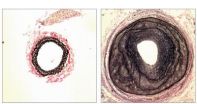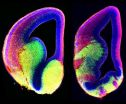(Press-News.org) WASHINGTON — Legal responses to juvenile offending should be grounded in scientific knowledge about adolescent development and tailored to an individual offender's needs and social environment, says a new report from the National Research Council. Accountability practices should not be carried over from criminal courts to juvenile courts; in particular, confinement should be used only in rare circumstances such as when a youth poses a high risk of harming others.
The specific aims of the juvenile justice system are to hold youths accountable for wrongdoing, prevent further offending, and treat offenders fairly. "Many jurisdictions are still operating under harsh laws passed in the 1990s that rejected the relevance of the developmental differences between adolescents and adults to justice policy," said committee chair Robert Johnson, dean of the New Jersey Medical School in Newark. "But adolescents' brains, behavior, and needs are different from those of adults, and states should align their laws and policies with that evidence."
Research shows that an imbalance in developing brain systems is linked to adolescents' lack of mature capability for self-regulation, heightened sensitivity to external influences, and poorer ability to make decisions that require consideration of the future. Individual development and likelihood of offending are also strongly affected by youths' interactions with their environment, which includes parents, peers, schools, and communities, the report says. Much adolescent involvement in illegal activity is an extension of the kind of risk-taking that is part of the developmental process, and most adolescents mature out of these activities.
Three conditions that are critically important to adolescent development are active involvement by a parent figure, peer groups that value positive socialization and academic success, and activities that contribute to decision-making and critical-thinking abilities, says the report. Juvenile justice system practices that rely on containment, confinement, and control can deprive youth of these resources.
Well-designed, community-based programs are more likely than institutional confinement to reduce recidivism and facilitate healthy social and moral development for most young offenders, the report says. Even in the most serious cases of personal violence, criminal court sentences should avoid confining adolescents in adult prisons. The report adds that juvenile records should remain confidential to increase opportunities for an offender's successful transition into adulthood.
The juvenile justice system should eliminate interventions that research has found to be ineffective or harmful, while engaging an adolescent, his or her family, and the community to foster positive activities and law-abiding behavior. Many effective developmentally based interventions also result in substantial cost benefits, such as relatively low-cost programs that divert adolescents from the justice system by reducing risk factors or that intervene while an offender is confined or on probation. Conversely, programs such as wilderness challenges and bootcamps have large costs and have been shown to be ineffective.
Minorities are disproportionately represented in the juvenile justice system, especially during the arrest and detention stages and for certain crimes. The report notes that minorities are more likely to face harsh punishment for some crimes and remain in the system longer than white youths for the same crimes. While the juvenile justice system alone cannot alter the underlying causes of racial and ethnic disparities, practices within the system that impact disparities could be addressed, for example setting guidelines for handling adolescents as they enter the juvenile justice system to avoid further processing. The committee calls for increasing the accountability of national, state, and local governments for reducing racial and ethnic disparities.
Juvenile courts should ensure that young offenders are represented by properly trained counsel, that legal decisions are not made unless the youth is competent enough to understand the proceedings and assist counsel, and that youths have an opportunity to participate in the proceedings, the report says. Evidence suggests that juveniles are more likely to accept responsibility if they perceive the proceedings to be fair and the sanctions to be appropriate to their offenses.
"Adolescents have a heightened sensitivity to perceived injustice, so being fair to juveniles is developmentally important as well as constitutionally important," said committee vice chair Richard Bonnie, professor of law and public policy at the University of Virginia, Charlottesville.
The immediate momentum for systemwide change will need to come from state, local, and tribal governments, the report says, but policymakers at all levels need to be engaged in the process and be transparent regarding the effectiveness and costs of current programs and policies. Federal research agencies should support research to continue to advance the science of adolescent development, and new findings should be incorporated into policies and practice on a continuing basis.
###
The study was sponsored by U.S. Department of Justice. The National Academy of Sciences, National Academy of Engineering, Institute of Medicine, and National Research Council make up the National Academies. They are private, independent nonprofit institutions that provide science, technology, and health policy advice under a congressional charter. The Research Council is the principal operating agency of the National Academy of Sciences and the National Academy of Engineering. For more information, visit http://national-academies.org. A committee roster follows.
Contacts:
Lauren Rugani, Media Relations Officer
Luwam Yeibio, Media Relations Assistant
Office of News and Public Information
202-334-2138; e-mail news@nas.edu
Additional resources:
Report in Brief
Pre-publication copies of Reforming Juvenile Justice: A Developmental Approach are available from the National Academies Press; tel. 202-334-3313 or 1-800-624-6242 or on the Internet at http://www.nap.edu. Reporters may obtain a copy from the Office of News and Public Information (contacts listed above).
NATIONAL RESEARCH COUNCIL
Division of Behavioral and Social Sciences and Education
Committee on Law and Justice
Committee on Assessing Juvenile Justice Reform
Robert L. Johnson (chair)
Dean and Director of Adolescent and Young Adult Medicine
New Jersey Medical School
Newark
Richard J. Bonnie1 (vice chair)
Harrison Foundation Professor of Medicine and Law;
Professor of Psychiatry and Neurobehavioral Sciences; and
Director of Psychiatry and Public Policy
Institute of Law
University of Virginia
Charlottesville
Carl C. Bell
President and CEO
Community Mental Health Council Inc.
Chicago
Lawrence D. Bobo2
W.E.B. Du Bois Professor of the Social Sciences
Department of Sociology
Harvard University
Cambridge, Mass.
Jeffrey A. Butts
Executive Director
Criminal Justice Research and Evaluation Center
John Jay College of Criminal Justice
City University of New York
New York City
Gladys Carrion
Commissioner
New York State Office of Children and Family Services
Rensselaer
B.J. Casey
Director
Sackler Institute, and
Sackler Professor of Developmental Psychobiology
Departments of Psychiatry, Neurology, and Neuroscience
Weill Medical College of Cornell University
New York City
Kenneth A. Dodge
William McDougall Professor of Public Policy, and
Director
Center for Child and Family Policy
Sanford School of Public Policy
Duke University
Durham, N.C.
Sandra A. Graham
Professor
Department of Education
Graduate School of Education
University of California
Los Angeles
Ernestine Gray
Chief Judge
Orleans Parish Juvenile Court
New Orleans
Edward P. Mulvey
Professor of Psychiatry, and
Director
Law and Psychiatry Research
School of Medicine
University of Pittsburgh
Pittsburgh
Robert D. Plotnick
Professor of Public Affairs and Social Work
University of Washington
Seattle
Elizabeth S. Scott
Harold R. Medina Professor in
Procedural Jurisprudence
Columbia Law School
Columbia University
New York City
Terence P. Thornberry
Professor of Criminology and Criminal Justice
University of Maryland
College Park
Cherie Townsend
Executive Director
Texas Juvenile Justice
Department
Austin
RESEARCH COUNCIL STAFF
Betty M. Chemers
Study Director
1 Member, Institute of Medicine
2 Member, National Academy of Sciences END
Juvenile justice reforms should incorporate science of adolescent development
2012-11-13
ELSE PRESS RELEASES FROM THIS DATE:
Sociology, economics researchers receive grant to study development across the human lifespan
2012-11-13
AUSTIN, Texas — University of Texas at Austin sociologist Chandra Muller and economist Sandra Black have received a $3.2 million grant from the Alfred P. Sloan Foundation to study the effects of cognition on health, mortality, education and employment from high school and beyond.
The three-year grant will support a study, led by Muller, that follows 14,825 respondents (born in 1964-65) of the nationally representative "High School and Beyond" survey. Designed and funded by the U.S. Department of Education, the multiphase survey examines educational, vocational and personal ...
BUSM study finds certain subgroups of black women have lower uptake of HPV vaccination
2012-11-13
(Boston) – A new Boston University School of Medicine (BUSM) study has found that improving Human papillomavirus (HPV) vaccination rates in black women may require culturally sensitive approaches that address ethnic-specific barriers. The findings are published online in the November/December issue of the journal, Women's Health Issues.
According to the Centers for Disease Control, HPV is the most common sexually transmitted infection. There are more than 40 HPV types that can infect the genital areas of males and females and in advanced stages, can cause cervical cancer. ...
Autism treatment is more than skin deep
2012-11-13
Metal-binding agents rubbed into the skin, prescribed by some alternative practitioners for the treatment of autism, are not absorbed and therefore are unlikely to be effective at helping the body excrete excess mercury. The study by Jennifer Cohen and Michelle Ruha from Banner Good Samaritan Medical Center in the US, and their colleagues, provides evidence against the use of these treatments in children with autism. Their work is published online in Springer's Journal of Medical Toxicology.
Metal-binding agents such as DMPS* have received significant attention in recent ...
Childhood abuse leads to poor adult health
2012-11-13
Montreal, November 13, 2012 – The psychological scars of childhood abuse
can last well into adulthood. New research from Concordia University shows the harm can have longterm negative physical effects, as well as emotional ones.
Scientists hypothesize that stress in early childhood causes physiological changes that affect a victim's response to stress, which puts the individual at an increased risk of disease later in life. Jean-Philippe Gouin, who holds a Canada Research Chair in Chronic Stress and Health in Concordia's Department of Psychology, tested this link and ...
Effects of alcohol on lymphoma, leukemia, and other types of hematological cancers
2012-11-13
Many observational epidemiologic studies have found an inverse association between alcohol consumption and hematological cancers (such as lymphoma and leukemia). This study, based on the Million Women's Study in the UK, is large enough to permit an evaluation of associations with various types of such cancers. Further, it takes into account newer coding systems for morphology so that diseases associated with the lymphatic system can be separated from those of the myeloid system.
The key findings are that alcohol consumption appears to lower the risk of several types ...
G proteins regulate remodelling of blood vessels
2012-11-13
This press release is available in German.
Blood vessels are extremely dynamic: depending on the external conditions, they can adapt their permeability for nutrients, their contractility, and even their shape. Unlike cardiac muscle cells, for example, the smooth muscle cells in blood vessels demonstrate a high degree of plasticity, so they can specialise or multiply as required, even repairing damage to the vessel wall. This vascular remodelling is evidently precisely regulated. Disruptions are extremely significant in conditions such as atherosclerosis or high blood ...
It pays to cooperate
2012-11-13
CAMBRIDGE, MA - Many species exhibit cooperative survival strategies — for example, sharing food or alerting other individuals when a predator is nearby. However, there are almost always freeloaders in the population who will take advantage of cooperators. This can be seen even among microbes such as yeast, where "cheaters" consume food produced by their neighbors without contributing any of their own.
In light of this, evolutionary biologists have long wondered why cooperation remains a viable survival strategy, since there will always be others who cheat. Now, MIT physicists ...
How online video stream quality affects viewer behavior
2012-11-13
AMHERST, Mass. – It may seem like common sense that the quality of online video streaming affects how willing viewers are to watch videos at a website. But until computer science researcher Ramesh Sitaraman at the University of Massachusetts Amherst and collaborators at Akamai developed a way to rigorously study the question, no one had been able to scientifically test the assumption.
They conducted the first large-scale study of its kind to quantitatively demonstrate how video stream quality causes changes in viewer behavior. "Video stream quality is a very big topic ...
Once the conflict is over, solidarity in alliances goes out of the window
2012-11-13
This press release is available in German.
It is not always wise to form an alliance while in a conflict or at war, especially when there is something to be shared afterward. Economists from the Max Planck Institute for Tax Law and Public Finance have now shown by game theory experiments that, as soon as the enemy is gone, in-group solidarity of alliances vanishes rapidly. Former brothers in arms fight even more vigorously over the spoils of a victory than strangers do. During the conflict, they expend together only half the effort of their enemy. Furthermore, when ...
Watching the developing brain, scientists glean clues on neurological disorder
2012-11-13
CHAPEL HILL, N.C. – As the brain develops, each neuron must find its way to precisely the right spot to weave the intricate network of links the brain needs to function. Like the wiring in a computer, a few misplaced connections can throw off functioning for an entire segment of the brain.
A new study by researchers at the University of North Carolina School of Medicine reveals how some nerve cells, called interneurons, navigate during the development of the cerebral cortex. Mutations in a key gene behind this navigation system underlie a rare neurological disorder called ...


